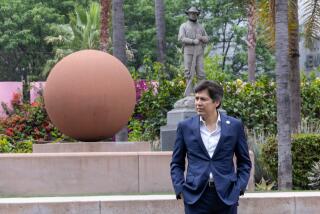Some City Squares Bring Lives, and History, Full Circle
- Share via
What does Carmen Miranda, the Brazilian actress made famous in the 1940s for her banana headdress and songs like “Chica Chica Boom Chick,” have in common with the Wolze brothers, Roy and Ray, two guys who founded a landmark hardware store on the Eastside?
Very little, of course.
Both, however, share the distinction of having small patches of Los Angeles concrete and asphalt named after them.
On Friday, Carmen Miranda Square in Hollywood joined Wolze Brothers Square in Lincoln Heights and Dosan Ahn Chang Ho Square near USC as one of a dozen Los Angeles city intersections named for historic personages.
“Carmen was a pioneer,” said Sergio Mielniczenko, a cultural attache to the Brazilian Consulate in Los Angeles. He was one of about 70 Brazilian diplomats, performers and fans who gathered Friday at the southeast corner of Hollywood Boulevard and Orange Drive to officially dedicate Carmen Miranda Square. “She was the first name that was widely known from Brazil.”
A city traffic sign will mark the square, which is just across the street from Mann’s Chinese Theatre, where Miranda’s footprints are preserved in concrete.
*
What does it mean to attach a name to a place? Will tourists feel compelled to samba when they visit Carmen Miranda Square? Do they reflect upon the future of Korea at Dosan Ahn Chang Ho Square, named for the early 20th century leader of the Korean independence movement? Do they see the world with noir-colored lenses when they visit Raymond Chandler Square at the intersection of Hollywood and Cahuenga boulevards, near a hotel where the crime novelist once lived?
“It keeps the name of people out there,” said Adolfo V. Nodal of the city of Los Angeles Cultural Affairs Department, which helped name Carmen Miranda Square. “Maybe some kid will look at [the sign] and do some research on who that person was.”
There is also Andrei Sakharov Square in Studio City, named for the Soviet dissident, and Jose Marti Square in Echo Park, memorializing the Cuban independence leader.
At the Lincoln Heights intersection more commonly known to local residents as “Five Points,” there is a beige marker identifying the location as Wolze Brothers Square. About a half block away, at Wolze Hardware, another sign proclaims the company motto: “If We Don’t Have It, You Don’t Need It.”
The late brothers are beloved locally for sharing the profits of their business with the community, helping to keep the nearby Los Angeles Boys and Girls Club and the Hollenbeck Youth Center up and running for decades.
There is a similar, though historically more distant, connection between Dosan Ahn Chang Ho Square--at Jefferson Boulevard and Van Buren Street--and the surrounding neighborhood. Ahn lived in the community in the first years of the 20th century, after being exiled from his country during its occupation by Japan.
*
Carmen Miranda’s link to the square that bears her name is twofold. First, there are the concrete footprints at the Chinese Theatre. Miranda made them in 1941, a year after “the Brazilian Bombshell” exploded on the Hollywood scene with her exuberant performance in “Down Argentine Way.”
Miranda, who died in 1955, is also remembered for her performance on a nearby Hollywood Boulevard street corner on V-J Day, when World War II ended, according to Johnny Grant, Hollywood’s honorary mayor.
A throng of servicemen began celebrating on the street, the band from the local USO club joining them in an impromptu parade near the corner of Hollywood and Vine. Then a convertible pulled up. Miranda popped out of a seat and started to do her famous dance, Grant said.
“It was like a madhouse, it was really something,” remembered 81-year-old Harry D’Almeida, a Brazilian singer who performed in Miranda’s band. “This brings so much emotion for an old man, it brings back so much memories,” said D’Almeida as the official sign was hoisted up and attached to a lamppost Friday. “I loved her. . . . This for me is something to remember in my last days.”
Times correspondent Joseph Trevino contributed to this story.
More to Read
Sign up for Essential California
The most important California stories and recommendations in your inbox every morning.
You may occasionally receive promotional content from the Los Angeles Times.














